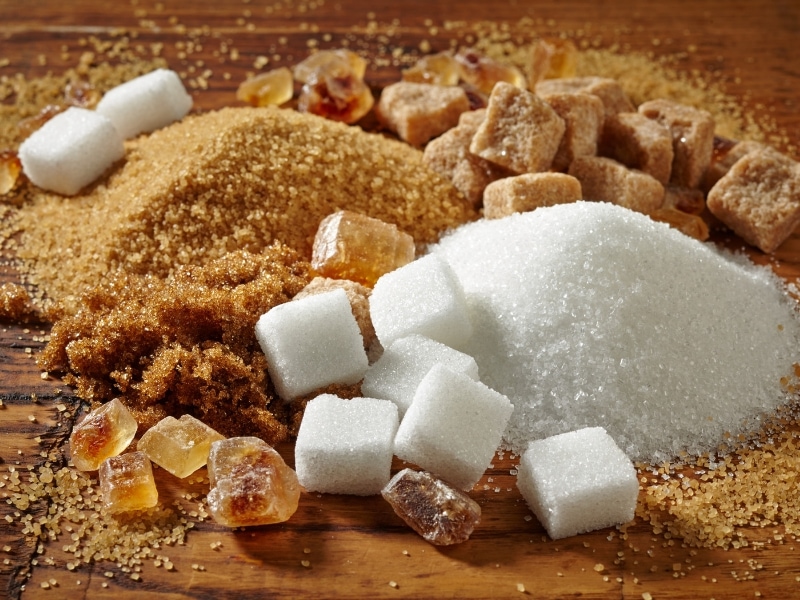Sugar comes in several forms, each with their own unique textures and flavors suiting different cooking needs. For example, turbinado has subtle caramel notes used in drinks and baking. Demerara sugar contains a mild molasses taste as a topping on goods.
Moreover, it serves as a preservative, thickener, and sweetener in foods and drinks. However, excessive added sugars risk harming health. It is important to limit highly refined sugars like table sugar and high fructose corn syrup, in favor of naturally occurring ones from fruits, vegetables and dairy.
White sugar undergoes extensive processing, while brown sugar retains molasses providing hints of depth. Confectioners’ sugar, very finely ground, coats and enhances flavors. Choosing the kind of sugar depends on the intended purpose.
What is the Definition of Sugar?
Sugar is a simple carbohydrate that occurs naturally in plants and is used to sweeten foods and beverages. It belongs to the carbohydrate family and provides a quick source of energy.
Scientific Definition:
Sugar refers to a group of sweet, soluble carbohydrates, mainly composed of carbon, hydrogen, and oxygen.
The most common types include glucose, fructose, sucrose, and lactose.
Common Sources of Sugar:
Natural Sugars: Found in fruits (fructose), milk (lactose), and honey.
Added Sugars: Refined sugar from sugarcane or sugar beets, used in processed foods.
Different Types of Sugar:
Monosaccharides (Simple Sugars): Glucose, fructose, galactose.
Disaccharides (Double Sugars): Sucrose (table sugar), lactose (milk sugar), maltose (found in grains).
Conclusion:
Sugar is a basic carbohydrate that provides sweetness and energy, whether from natural sources like fruits or added sugars in baked goods and desserts.
What is Sugar Made Out Of?
Sugar is primarily made up of carbon (C), hydrogen (H), and oxygen (O) molecules.
1. Natural Sources of Sugar
Sugarcane & Sugar Beets: The most common sources of table sugar (sucrose).
Fruits: Contain fructose, a natural sugar.
Milk & Dairy Products: Contain lactose.
Honey & Maple Syrup: Contain a mix of glucose and fructose.
2. Process of Making Sugar
Sugar is extracted from sugarcane or sugar beets.
The juice is filtered, boiled, and crystallized into granulated sugar.
Depending on processing, different types of sugar are produced (white sugar, brown sugar, raw sugar).
3. Chemical Composition
Sucrose (C₁₂H₂₂O₁₁) is the scientific name for table sugar, composed of glucose and fructose molecules.
Conclusion:
Sugar is a naturally occurring carbohydrate, extracted from plants and refined into different types used in food and beverages.
What Sugar is Used in Cooking?
Different types of sugar are used in cooking, each offering unique textures, flavors, and properties.
1. Granulated Sugar (Table Sugar)
Most common sugar used in everyday cooking.
Dissolves easily in liquids, making it ideal for sweetening drinks, sauces, and syrups.
2. Brown Sugar
Contains molasses, giving it a rich, caramel-like flavor.
Used in BBQ sauces, marinades, and baked goods.
3. Powdered Sugar (Confectioners’ Sugar)
Finely ground sugar mixed with cornstarch to prevent clumping.
Used for icing, frostings, and dusting desserts.
4. Raw Sugar (Turbinado, Demerara)
Less processed than white sugar, with a slight molasses flavor.
Used for sprinkling on baked goods or in beverages.
5. Honey & Maple Syrup
Natural sweeteners used for a richer flavor in dressings, marinades, and desserts.
6. Coconut Sugar
Derived from coconut sap, it has a caramel-like taste.
Used as a natural alternative to refined sugar.
Conclusion:
The type of sugar you use depends on the recipe and desired texture, whether it’s granulated sugar for general cooking, brown sugar for depth, or powdered sugar for decorating desserts.
Which Sugar is Best for Baking Cakes?
The right sugar can affect a cake’s texture, moisture, and sweetness.
1. Granulated Sugar
Best for most cakes as it dissolves easily.
Provides a light, fluffy texture when creamed with butter.
2. Brown Sugar
Adds moisture and chewiness, great for moist cakes like banana cake or chocolate cake.
Provides a slight caramel flavor.
3. Powdered Sugar
Used mainly in frostings and glazes, not for baking the cake itself.
4. Caster Sugar (Superfine Sugar)
Smaller crystals than granulated sugar, making it perfect for sponge cakes.
Dissolves quickly for a smooth batter.
5. Coconut Sugar
A healthier alternative but may slightly alter the texture and flavor.
6. Honey & Maple Syrup
Used in moist, dense cakes but must be adjusted with other ingredients.
Conclusion:
For a light and fluffy cake, granulated sugar is best. For moist, rich cakes, brown sugar or a mix of sugars works well.
What is the Role of Sugar in Cooking?
Sugar does more than just sweeten food—it plays a vital role in texture, color, and preservation.
1. Sweetening
Enhances the flavor of desserts, beverages, and sauces.
2. Moisture Retention
Sugar helps baked goods stay soft and moist, preventing them from drying out.
3. Browning & Caramelization
Sugar caramelizes at high heat, giving baked goods, sauces, and roasted foods a golden color.
4. Texture & Structure
In baking, sugar helps create tenderness by absorbing moisture.
It assists in leavening cakes and cookies by trapping air when creamed with butter.
5. Preservative in Jams & Jellies
Sugar prevents microbial growth, acting as a natural preservative.
6. Balancing Flavors
A touch of sugar balances acidic or spicy foods, making dishes taste more harmonious.
7. Fermentation in Bread
Sugar feeds yeast in bread-making, helping dough rise.
Conclusion:
Sugar isn’t just for sweetness—it contributes to moisture, texture, preservation, and flavor balance in cooking and baking.
How To Store
Choose a cool and dry location away from direct sunlight. This will best maintain its over time. Also, make sure to transfer it to airtight containers. By doing so, this prevents moisture from being absorbed which could cause it to clump together.
Alternatives
Honey, Maple Syrup, Applesauce, Fruits, Molasses, Coconut Sugar, Stevia,Chickory Root Fiber, Monk Fruit Extract,Yacon Syrup , Fruit Juice Concentrate

